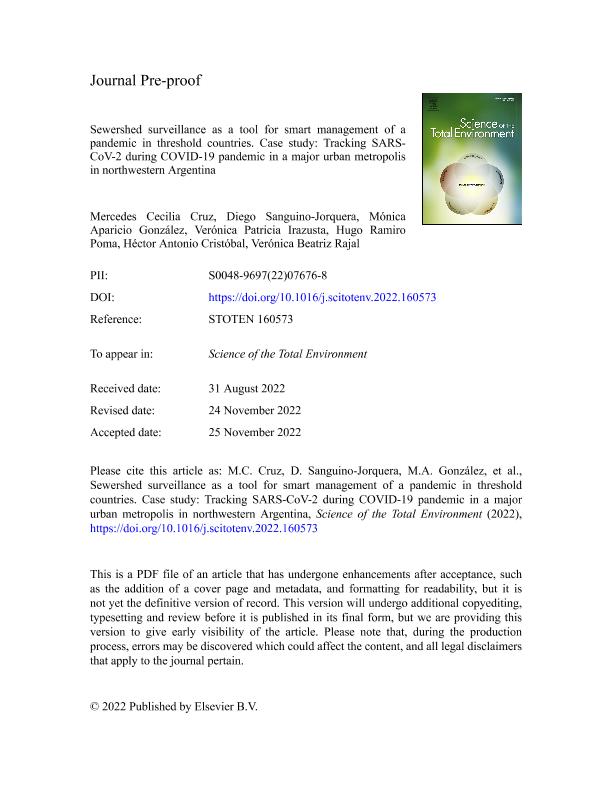Artículo
Sewershed surveillance as a tool for smart management of a pandemic in threshold countries. Case study: Tracking SARS-CoV-2 during COVID-19 pandemic in a major urban metropolis in northwestern Argentina
Cruz, Mercedes Cecilia ; Sanguino Jorquera, Diego Gastón
; Sanguino Jorquera, Diego Gastón ; Aparicio González, Mónica Alicia
; Aparicio González, Mónica Alicia ; Irazusta, Verónica Patricia
; Irazusta, Verónica Patricia ; Poma, Hugo Ramiro
; Poma, Hugo Ramiro ; Cristobal, Hector Antonio
; Cristobal, Hector Antonio ; Rajal, Verónica Beatriz
; Rajal, Verónica Beatriz
 ; Sanguino Jorquera, Diego Gastón
; Sanguino Jorquera, Diego Gastón ; Aparicio González, Mónica Alicia
; Aparicio González, Mónica Alicia ; Irazusta, Verónica Patricia
; Irazusta, Verónica Patricia ; Poma, Hugo Ramiro
; Poma, Hugo Ramiro ; Cristobal, Hector Antonio
; Cristobal, Hector Antonio ; Rajal, Verónica Beatriz
; Rajal, Verónica Beatriz
Fecha de publicación:
03/2023
Editorial:
Elsevier Science
Revista:
Science of the Total Environment
ISSN:
0048-9697
Idioma:
Inglés
Tipo de recurso:
Artículo publicado
Clasificación temática:
Resumen
Wastewater-based epidemiology is an economical and effective tool for monitoring the COVID-19 pandemic. In this study we proposed sampling campaigns that addressed spatial-temporal trends within a metropolitan area. This is a local study of detection and quantification of SARS-CoV-2 in wastewater during the onset, rise, and decline of COVID-19 cases in Salta city (Argentina) over the course of a twenty-one-week period (13 Aug to 30 Dec) in 2020. Wastewater samples were gathered from 13 sewer manholes specific to each sewershed catchment, prior to convergence or mixing with other sewer lines, resulting in samples specific to individual catchments with defined areas. The 13 sewershed catchments selected comprise 118,832 connections to the network throughout the city, representing 84.7 % (534,747 individuals) of the total population. The number of COVID19-related exposure and symptoms cases in each area were registered using an application developed for smartphones by the provincial government. Geographical coordinates provided by the devices were recorded, and consequently, it was possible to geolocalise all app-cases and track them down to which of the 13 sampling catchments belonged. RNA fragments of SARS-CoV-2 were detected in every site since the beginning of the monitoring, anticipating viral circulation in the population. Over the course of the 21-week study, the concentrations of SARS-CoV-2 ranged between 1.77 × 104 and 4.35 × 107 genome copies/L. There was a correspondence with the highest viral load in wastewater and the peak number of cases reported by the app for each catchment. The associations were evaluated with correlation analysis. The viral loads of SARS-CoV-2 in wastewater were a feasible means to describe the trends of COVID-19 infections. Surveillance at sewershed scale, provided reliable and strategic information that could be used by local health stakeholders to manage the COVID-19 pandemic.
Archivos asociados
Licencia
Identificadores
Colecciones
Articulos(INIQUI)
Articulos de INST.DE INVEST.PARA LA INDUSTRIA QUIMICA (I)
Articulos de INST.DE INVEST.PARA LA INDUSTRIA QUIMICA (I)
Citación
Cruz, Mercedes Cecilia; Sanguino Jorquera, Diego Gastón; Aparicio González, Mónica Alicia; Irazusta, Verónica Patricia; Poma, Hugo Ramiro; et al.; Sewershed surveillance as a tool for smart management of a pandemic in threshold countries. Case study: Tracking SARS-CoV-2 during COVID-19 pandemic in a major urban metropolis in northwestern Argentina; Elsevier Science; Science of the Total Environment; 862; 160573; 3-2023; 1-11
Compartir
Altmétricas



